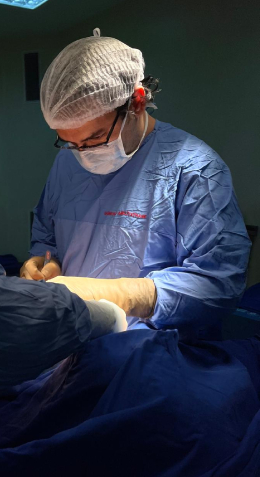Otoplasty (Prominent Ear Surgery)
Otoplasty (Prominent Ear Surgery)
Otoplasty
What is Otoplasty?
The word oto- means ‘ear’, while the word ‘-plasty’ means ‘reshaping’. Otoplasty surgery, also known as prominent ear correction or prominent ear surgery, is performed when the ears are prominently protruding or large.
Prominent ear deformity refers to a condition in which the angle between the auricle and the head is greater than normal. This deformity is sometimes accompanied by a flattening of the ear fold and an increase in the height of the cartilage. However, this surgery does not only take the ear back, but if the accompanying pathologies are not intervened, there is a frequent risk of reopening.
Why is Otoplasty Performed?
People prefer otoplasty for various reasons:
Congenital Anomalies: Some people may not find the shape or size of their ears satisfactory. Otoplasty is preferred to correct congenital ear anomalies.
Auditory Problems: In some cases, the position of the ears can affect hearing function. Otoplasty can also be performed to correct such functional problems.
Injuries: Ear deformities caused by accidents or trauma can cause people to opt for otoplasty.
Are the results of otoplasty permanent?
Although the new shape and position of the ears after prominent ear surgery is usually permanent, some changes may occur over time. With the aging of the person, a natural aging process occurs in the skin and tissues. In this process, the ears may also undergo minor changes. Especially with the decrease in skin elasticity, the ears may sag a little. The healing of the sutures made during otoplasty is also important. During the healing process, the suture lines may become prominent, but over time they usually become less noticeable.
How is prominent ear aesthetics (surgery) performed?
Prominent ear aesthetics is a surgical procedure performed with a very small incision behind the ear. In this procedure, a permanent improvement in the auricle is provided. During the operation, the cartilage structures in the ear are brought to the appropriate angle and shaped using permanent sutures. In this way, the unwanted auricle shape is corrected and a more natural appearance is achieved.
The biggest advantage of the surgery is that the prominent ear deformity is not likely to occur again. That is, the correction made once is usually permanent. During the surgery, general anaesthesia is applied to children under the age of 10-12, while local anaesthesia can be applied to older people. The operation takes approximately one hour for both ears.
After the operation, a compression bandage is applied to the ears. People who are not under general anaesthesia are discharged from the hospital on the same day. The bandages on the ears are not opened for 5 days. At the end of this period, the bandages are opened by the doctor and tennis bands are attached to the ears of the patients.
After prominent ear aesthetics, there is no visible scar and successful surgeries increase the self-confidence of people and make them look at life more positively.
Things to Consider After Otoplasty
Some important points to be considered after otoplasty are as follows:
Avoid Pressure and Friction: Avoid applying direct pressure or rubbing on your ears after surgery.
Head Height: Sleep with your head supported by a high pillow. This can help reduce swelling.
Suture Care: Take care of the stitches as recommended by your doctor and contact your doctor immediately if there are any signs of infection.
How long after ear aesthetic surgery can I return to my normal life?
The process of returning to normal life after prominent ear aesthetic surgery can usually vary according to the person's recovery rate and your surgeon's recommendation. Immediately after the surgery, you can usually be discharged from the hospital on the same day. However, there may be mild headache, mild discomfort and a feeling of pressure in the ears during this period. You can return to light activities within a few days after the operation. However, heavy sports or exercise should be avoided. The bandages on the ears are usually kept for 5 days and removed at the end of this period. You can return to normal daily activities within a week after the bandages are removed. However, it is important to avoid putting too much pressure on the ears, lifting heavy loads and traumas. During the first month after the operation, swelling and tenderness of the ears may persist. During this period, it is important to protect from the sun and excessive heat, and to stay away from environments with risk of infection such as swimming pools or the sea. Swelling and tenderness in the ears usually decrease within the first 6 months. However, the full recovery process may take a little longer. During this period, it is important to follow your doctor's recommendations and not neglect regular check-ups.
Are There Risks of Otoplasty?
Otoplasty surgery, like any surgical procedure, has certain risks. These may include infection, bleeding, prominent suture line, wound healing problems and anaesthesia-related complications. However, these risks are usually low and can be minimised under the control of an expert surgeon with high surgical experience.
Who May Be Suitable for Otoplasty Surgery?
Otoplasty surgery is suitable for people who are unhappy with the appearance or functionality of their ears and are in good general health. In addition, individuals who are uncomfortable with their ears in children or adolescence may also be suitable candidates for otoplasty. However, it is important to inform the patient about expectations and postoperative care prior to surgery.


